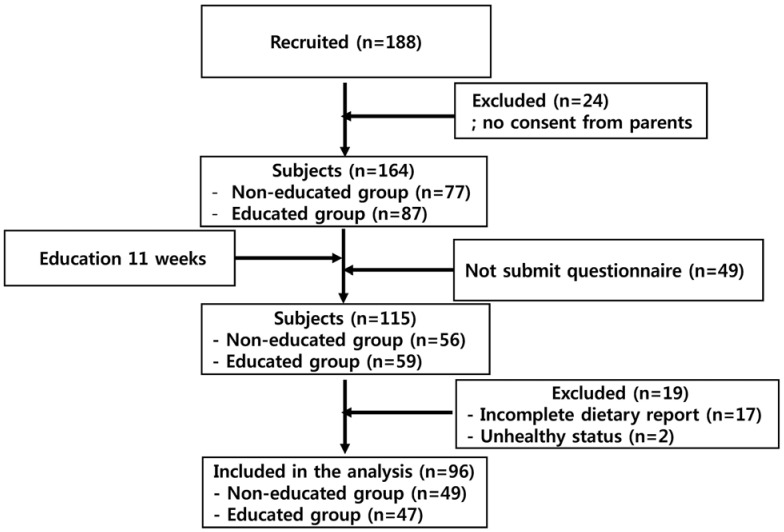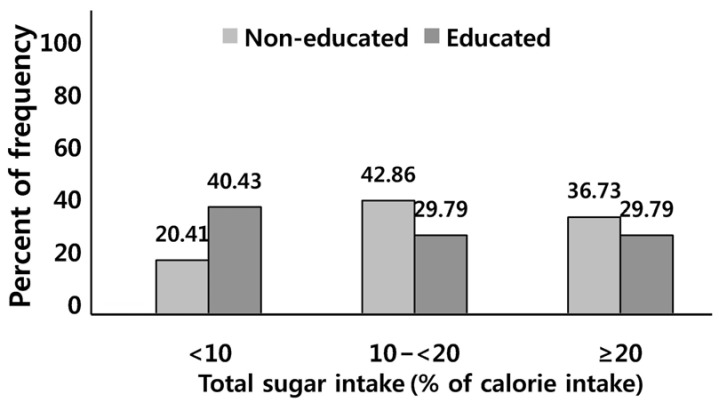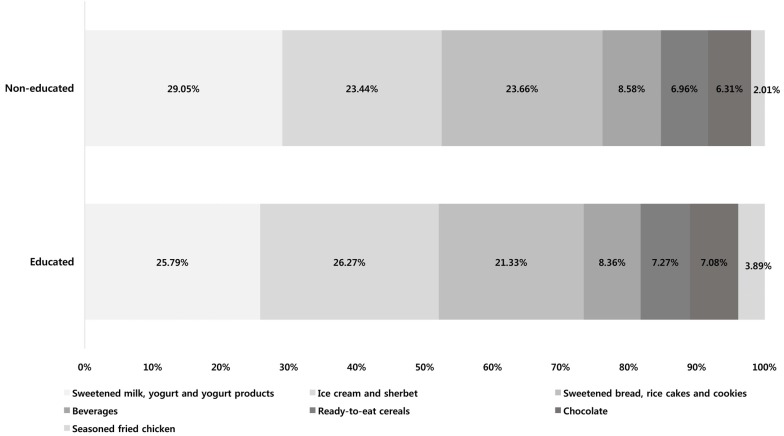Nutr Res Pract.
2019 Oct;13(5):434-443. 10.4162/nrp.2019.13.5.434.
Nutrition education discouraging sugar intake results in higher nutrient density in diets of pre-school children
- Affiliations
-
- 1Department of Food and Nutrition, Duksung Women's University, 33, Samyangro 114 Gill, Dobonggu, Seoul, 01369, South Korea. yunokcho@duksung.ac.kr
- KMID: 2464123
- DOI: http://doi.org/10.4162/nrp.2019.13.5.434
Abstract
- BACKGROUND/OBJECTIVES
The intake of sugar has increased worldwide, and it is well established that childhood experiences and food preferences affect lifelong eating habits. To discourage sugar intake, nutrition education was imparted, and the effectiveness of the nutrition education program was investigated by considering the nutrient density and major dietary sources of sugar intake.
SUBJECTS/METHODS
Twenty four-hour dietary recall and sugar intake frequency of 96 pre-school children (educated n = 47; non-educated n = 49) were collected on 3 consecutive days (1 weekend day, 2 weekdays) after 11 weeks of imparting nutrition education. Dietary intake of nutrients and total sugar were analyzed, and the intake frequency of sugar source foods were identified. All nutrition education programs were focused on a hands-on education program, and consisted of cooking lab, play, activity, animation, and visual materials. The difference between the two groups was verified by the Chi-square test or t-test. All statistical analysis was performed with significance level at P < 0.05.
RESULTS
Compared to the non-educated group, the intakes of protein (P < 0.001), fiber (P < 0.01), potassium (P < 0.05), iron (P < 0.05), zinc (P < 0.05), and iodine (P < 0.001) were significantly higher, and the intakes of carbohydrate (P < 0.01) and total sugar (P < 0.05) were significantly lower in the educated group. The cumulative percent of sugar intake of top 20 sugar source foods in the educated group (82.80%) was lower than that of the non-educated group (85.75%). The contribution of beverages on total sugar intake was lower in the educated group. The average frequency of consuming sugary foods was significantly lower in the educated group (P < 0.05).
CONCLUSIONS
Our results indicate that nutrition education on discouraging sugar intake is effective in reducing the amount of total sugar consumed, resulting higher nutrient density in the diets of pre-school children.
MeSH Terms
Figure
Reference
-
1. Kang KJ. A study on food habits, nutrient intakes and nutritional quality of preschool children in Seoul. Korean J Community Nutr. 2005; 10:471–483.2. Okubo H, Miyake Y, Sasaki S, Tanaka K, Hirota Y. Early sugar-sweetened beverage consumption frequency is associated with poor quality of later food and nutrient intake patterns among Japanese young children: the Osaka Maternal and Child Health Study. Nutr Res. 2016; 36:594–602. PMID: 27188905.
Article3. Skinner JD, Carruth BR, Bounds W, Ziegler P, Reidy K. Do food-related experiences in the first 2 years of life predict dietary variety in school-aged children? J Nutr Educ Behav. 2002; 34:310–315. PMID: 12556269.
Article4. Ventura AK, Worobey J. Early influences on the development of food preferences. Curr Biol. 2013; 23:R401–R408. PMID: 23660363.
Article5. World Health Organization. Guideline: Sugars Intake for Adults and Children. Geneva: World Health Organization;2015. p. 1–3.6. Korea Ministry of Food and Drug Safety. Excessive the intake of sugars of one in two (46.3%) in children and adolescent [Internet]. Cheongju: Korea Ministry of Food and Drug Safety;2016. cited 2019 January 17. Available from: http://www.mfds.go.kr.7. Korea Ministry of Food and Drug Safety. Increased sugar in take through processed foods trend [Internet]. Cheongju: Korea Ministry of Food and Drug Safety;2014. cited 2019 January 17. Available from: http://www.mfds.go.kr.8. Lee HS, Kwon SO, Yon M, Kim D, Lee JY, Nam J, Park SJ, Lee JY, Lee SK, Lee HY, Kwon OS, Kim CI. Dietary total sugar intake of Koreans: based on the Korea National Health and Nutrition Examination Survey (KNHANES), 2008–2011. J Nutr Health. 2014; 47:268–276.
Article9. Yeom MY, Cho YO. Evaluation of a nutrition education program designed to reduce sugar intake in preschool children. J Korean Diet Assoc. 2016; 22:179–192.
Article10. Kim MH, Kim NH, Yeon JY. Development and evaluation of the children's sugars intake reduction program. Korean J Food Nutr. 2018; 31:335–344.11. McCullough FS, Yoo S, Ainsworth P. Food choice, nutrition education and parental influence on British and Korean primary school children. Int J Consum Stud. 2004; 28:235–244.
Article12. Foterek K, Buyken AE, Bolzenius K, Hilbig A, Nöthlings U, Alexy U. Commercial complementary food consumption is prospectively associated with added sugar intake in childhood. Br J Nutr. 2016; 115:2067–2074. PMID: 27079145.
Article13. Han HM, Lee SS. A nutrition education program development and the application for the elementary students: focused on sugar intake education. J Korean Pract Arts Educ. 2008; 21:111–131.14. Kim YS, Lee MJ. Effects of nutrition education through social cognitive theory in elementary school students: focusing on the nutrition education of sugar intake. Korean J Food Nutr. 2011; 24:246–257.
Article15. Park H. Developing a Nutrition Education Model for Reducing Sugar Intake. Cheongju: Ministry of Food and Drug Safety;2013. p. 168–174.16. Murimi MW, Moyeda-Carabaza AF, Nguyen B, Saha S, Amin R, Njike V. Factors that contribute to effective nutrition education interventions in children: a systematic review. Nutr Rev. 2018; 76:553–580. PMID: 29800311.
Article17. Choo JH, Chung KM. Effect of direct and indirect visual exposure to increase toddlers' vegetable eating. Korean J Health Psychol. 2013; 18:687–708.18. Lee SJ, Chung KM. Effect of an exposure program to vegetables to increase young children's vegetable consumption. Korean J Health Psychol. 2015; 20:425–444.19. Appleton KM, Tuorila H, Bertenshaw EJ, de Graaf C, Mela DJ. Sweet taste exposure and the subsequent acceptance and preference for sweet taste in the diet: systematic review of the published literature. Am J Clin Nutr. 2018; 107:405–419. PMID: 29566187.
Article20. Kim SY, Kim HS. The effect of cooking activities on the unbalanced dietary food habits of elementary school children. Korean J Food Cult. 2008; 23:556–562.21. Seo JY, Choi BS, Lee IS. Effects of nutritional education featuring cooking activities on preschool children in the Daegu area: food habits and dietary attitudes. J East Asian Soc Diet Life. 2010; 20:794–801.22. Sullivan SA, Birch LL. Pass the sugar, pass, the salt: experience dictates preference. Dev Psychol. 1990; 26:546–551.
Article23. Wardle J, Herrera ML, Cooke L, Gibson EL. Modifying children's food preferences: the effects of exposure and reward on acceptance of an unfamiliar vegetable. Eur J Clin Nutr. 2003; 57:341–348. PMID: 12571670.
Article24. Anzman-Frasca S, Savage JS, Marini ME, Fisher JO, Birch LL. Repeated exposure and associative conditioning promote preschool children's liking of vegetables. Appetite. 2012; 58:543–553. PMID: 22120062.
Article25. Fildes A, van Jaarsveld CH, Wardle J, Cooke L. Parent-administered exposure to increase children's vegetable acceptance: a randomized controlled trial. J Acad Nutr Diet. 2014; 114:881–888. PMID: 24091061.
Article26. de Wild VW, de Graaf C, Jager G. Effectiveness of flavour nutrient learning and mere exposure as mechanisms to increase toddler's intake and preference for green vegetables. Appetite. 2013; 64:89–96. PMID: 23357431.
Article27. Seoul Metropolitan Government. Story of sweet taste [Internet]. Seoul: Seoul Food Life Support Center;2016. cited 2017 March 6. Available from: https://www.seoulnutri.co.kr/education/61.do.28. Korea Ministry of Food and Drug Safety. Story of new sugar [Internet]. Cheongju: Korea Ministry of Food and Drug Safety;2014. cited 2017 March 6. Available from: https://www.foodsafetykorea.go.kr.29. Korea Ministry of Food and Drug Safety. Aha! Sugar! It's [Internet]. Cheongju: Korea Ministry of Food and Drug Safety;2014. cited 2019 January 17. Available from: http://www.mfds.go.kr.30. Wise PM, Nattress L, Flammer LJ, Beauchamp GK. Reduced dietary intake of simple sugars alters perceived sweet taste intensity but not perceived pleasantness. Am J Clin Nutr. 2016; 103:50–60. PMID: 26607941.
Article31. Korea Centers for Disease Control and Prevention. Development of the 2017 Korean national growth charts for children and adolescents [Internet]. Cheongju: Korea Centers for Disease Control and Prevention;2018. cited 2019 January 21. Available from: http://www.cdc.go.kr.32. Korea Ministry of Food and Drug Safety, Center for Children's Foodservice Management. Guidelines of feeding facility for preschool children; adequate amount of meal [Internet]. Cheongju: Korea Ministry of Food and Drug Safety;2013. cited 2017 March 6. Available from: https://ccfsm.foodnara.go.kr/home/?menuno=158.33. The Rural Development Administration. Korean food composition table (9th) [Internet]. Jeonju: The Rural Development Administration;2017. cited 2019 March 18. Available from: http://koreanfood.rda.go.kr/kfi/fct/fctFoodSrch/list.34. Korea Ministry of Food and Drug Safety. Ingredients food and nutrition [Internet]. Cheongju: Korea Ministry of Food and Drug Safety;2017. cited 2018 February 17. Available from: https://www.foodsafetykorea.go.kr.35. United States Department of Agriculture. USDA food composition database [Internet]. Beltsville (MD): United States Department of Agriculture;2018. cited 2018 February 21. Available from: https://ndb.nal.usda.gov/ndb/search/list?home=true.36. Korea Centers for Disease Control & Prevention. Food frequency questionnaires of Korea national health & nutrition examination survey [Internet]. Cheongju: Korea Centers for Disease Control & Prevention;2016. cited 2019 January 17. Available from: https://knhanes.cdc.go.kr/knhanes/.37. Kim SY, Kim MH, Kang MH, Choi MK. Association of total sugars intake with nutrient density and obesity degree in elementary school students in Chungnam. J East Asian Soc diet life. 2017; 27:176–184.
Article38. Gibson S, Boyd A. Associations between added sugars and micronutrient intakes and status: further analysis of data from the national diet and nutrition survey of young people aged 4 to 18 years. Br J Nutr. 2009; 101:100–107. PMID: 18606045.
Article39. Ministry of Health and Welfare, The Korean Nutrition Society. Dietary Reference Intakes for Koreans 2015. Cheongju: Ministry of Health and Welfare, The Korean Nutrition Society;2015. p. 855–862.40. Chung CE. Dietary intakes and food sources of total sugars from Korean national health and nutrition examination survey 2001–2002. Korean J Nutr. 2007; 40(Suppl):9–21.41. Azaïs-Braesco V, Sluik D, Maillot M, Kok F, Moreno LA. A review of total & added sugar intakes and dietary sources in Europe. Nutr J. 2017; 16:6. PMID: 28109280.
Article42. Lei L, Rangan A, Flood VM, Louie JC. Dietary intake and food sources of added sugar in the Australian population. Br J Nutr. 2016; 115:868–877. PMID: 26794833.
Article43. Brisbois TD, Marsden SL, Anderson GH, Sievenpiper JL. Estimated intakes and sources of total and added sugars in the Canadian diet. Nutrients. 2014; 6:1899–1912. PMID: 24815507.44. Afeiche MC, Koyratty BN, Wang D, Jacquier EF, Lê KA. Intakes and sources of total and added sugars among 4 to 13-year-old children in China, Mexico and the United States. Pediatr Obes. 2018; 13:204–212. PMID: 28960843.
Article45. Hetherington MM, Pirie LM, Nabb S. Stimulus satiation: effects of repeated exposure to foods on pleasantness and intake. Appetite. 2002; 38:19–28. PMID: 11883914.
Article46. Liem DG, de Graaf C. Sweet and sour preferences in young children and adults: role of repeated exposure. Physiol Behav. 2004; 83:421–429. PMID: 15581664.
Article47. Langlois K, Garriguet D, Gonzalez A, Sinclair S, Colapinto CK. Change in total sugars consumption among Canadian children and adults. Health Rep. 2019; 30:10–19. PMID: 30649778.
- Full Text Links
- Actions
-
Cited
- CITED
-
- Close
- Share
- Similar articles
-
- The Association between Maternal Nutrition Knowledge, Dietary attitudes, and Dietary Behaviors Related to Sugar Intake, and Sugar Intake Reduction in Preschool Children
- Relationships between Nutrient Intake Status and Sugar-containing Food Intake of Elementary School Students in Daegu-Kyungbook Area
- Utilization of Nutrition Labels and Its Relation to Nutrient Intake among Cancer Survivors: The 2019–2021 Korea National Health and Nutrition Examination Survey
- Awareness and Practice of Sugar Reduction in School Foodservice and the Practice of Nutrition Education in Daegu
- Analysis of the consumer perception and related education effect on the reduction of sugar for elementary school students in Seoul and Gyeonggi-do




